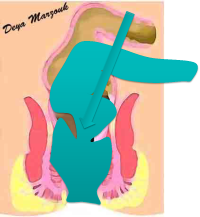
Obstruted Defaecation Web

| Rectal Wall Bends: S & Corckscrew Rectums |
|
Rectal wall abnormalities is a term which is collectively used to describe abnormal rectal wall anatomy that occurs with Rectal & pelvic viscera prolapse. These are often associated with defaecatory symptoms, With increasing descent & prolapse of pelvic floor & viscera, the rectum assumes one of 3 possible configurations. These are: 1. Internal Rectal Intussusception [the most common] 2. S Shaped rectum 3. Corckscrew rectum Internal rectal intussusception results from prolapse of the sigmoid or upper rectum inside the mid and distal rectum & is discussed separately in its separate web page, S shaped rectum & Corckscrew rectum are closely related and result from abnormal lateral or spiral bending of rectal wall. These are discussed here. The factors that determine which configuration predominates is ill understood, but most likely depend on a variety of factors including the original rectal configuration, the degree of redundancy of sigmoid, position of other pelvic viscera, laxity of perirectal fascia and any fixed points secondary to previous surgery. Not uncommonly, internal intussusception is accompanied by either S shaped rectum or corckscrew rectum Clinical detection of S shaped rectum & corckscrew rectum relies on the use of an educated finger, especially using a corckscrew test. Detection of internal rectal intussusception depend on using the hook test. These clinical tests are described elsewhere. The distinction between the subtypes is not easy, but an experienced digital rectal examination usually provides a clue to the abnormal anatomy. Proctography further define these anatomical abnormalities. Anteroposterior views during proctography is more helpful on defining S shaped rectum. These abnormalities can be an important missed cause of obstructed defaecation,. Symptoms include 1) obstructed defaecation symptoms including incomplete evacuation and in particular patient may report the need to use fingers to support the both sides of the perineum during defaecation, as well as digital evacuation of rectum ["fishing faecal pellets"]. 2) Some patients complain of bowel frequency passing faecal pellets, urgency & post defaecation faecal incontinence. The distinction between the subtypes of rectal wall abnormalities is less important if patients are treated conservatively, with irrigation or with laparoscopic resection rectopexy involving very deep dissection of rectum. On the other hand the distinction is important if patients are treated with lesser procedures such as STARR or TRANS-STARR, which are inadequate for lateral bend abnormalities. The differentian between S shaped rectum & Corckscrew rectum is also acadaemic. Both produce similar symptoms [although corckscrew more likely to be symptomatic] & are treated in a similar way. |